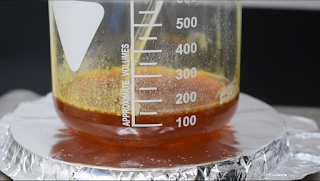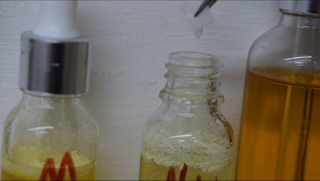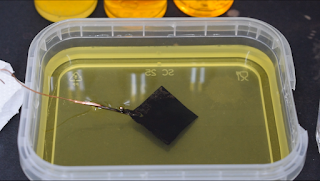How to Make Liver of Sulfur and Colorful Patina on Copper
by CuForming in Workshop > Science
9283 Views, 28 Favorites, 0 Comments
How to Make Liver of Sulfur and Colorful Patina on Copper

There are different ways to make Patina on metal, but the most mysterious and still popular way to do it is with Liver of sulfur. In this tutorial, I will resume my three videos from YouTube about LoS. I will teach you how to produce LoS in different ways, and I will also show you how to use it to make different patina colors on copper.
Supplies
In the first video, I will show you how to make it in less than one hour with small lab equipment.
This method is safe, but it requires a little care when we manipulate the substances.
Three simple ingredients are needed:
- Distilled water: 100ml
- Sodium Hydroxide: 20g https://ebay.to/3XKCr0j
- Pure Sulfur: 5g https://ebay.to/3B2r2z7
The equipment needed is:
- Gloves https://ebay.to/36ENtxX | https://amzn.to/3iss698 | https://s.click.aliexpress.com/e/_DdpYFa3
- Measuring scale https://ebay.to/3C3tchF | https://amzn.to/3OSKZyf | https://s.click.aliexpress.com/e/_DmraRjH
- Beaker http://ebay.to/3J2Jl8H | https://amzn.to/3VDg1w4 | https://s.click.aliexpress.com/e/_DnruREj
- Glass stirring rod https://ebay.to/3VLTH3z | https://amzn.to/3VIHxZa | https://s.click.aliexpress.com/e/_DFcsX23
- Electric stove https://ebay.to/3B0bXhn | https://amzn.to/3OQOYeq | https://s.click.aliexpress.com/e/_Dn2P50n
- (or) Heat stirrer https://ebay.to/3ugWDcC | https://amzn.to/3ESrFwq | https://s.click.aliexpress.com/e/_DCbwvwL
- Coffee filters https://ebay.to/3gO89cr | https://amzn.to/3irUQyG | https://s.click.aliexpress.com/e/_DCw7th1
- Funnel (HDPE or glass) https://ebay.to/3P6s3MB | https://amzn.to/3gOu5Ea | https://s.click.aliexpress.com/e/_Dd0QYeX
- Sealed glass jar https://ebay.to/3ugcNCY | https://amzn.to/3uyItUx
- (or) Dropper bottle https://ebay.to/3OT0V3p | https://amzn.to/3B16cQz | https://s.click.aliexpress.com/e/_DlZBJpv

***Sodium Hydroxide also called Lye or Caustic Soda is dangerous***. BE CAREFUL WITH IT. If you are not familiar with it wear eye protection, wear gloves and use it with a fume extractor or in a ventilate area or even wear a respirator mask. Don't pour water in solid lye, it will start to splash all around. Don't put your face over the beaker. Don't touch it with wet hands if it is solid, don't touch it if it's dissolved, don't touch it at all. The solution is exothermic, it means that it's gonna get hot. Be aware that the temperature will reach 70 °C.
I'm doing it under my fume extractor, I don't recommend making it in under your kitchen hood, it's gonna make your kitchen stink for days. Do it outside.
Pour the distilled water in your beaker and turn on your stove to medium heat.
Add sodium hydroxide into the water and let it dissolve completely.
When the solution starts to boil, add the sulfur powder and let it dissolve in to the sodium hydroxide solution.
During this process we need to stir the solution once in a while with a glass stirrer (not necessary if we use a magnetic stirrer) and if needed we can wash the sides of the beaker with little water to let the sulfur go down.
The solution will start becoming yellow, then orange and at the end dark red.
Leave it to boil until all the sulfur is completely dissolved or when the color is very dark. Sometime, small particles of sulfur don't want to melt in the solution. It'll take around 30 minutes and when it's done we may wanna leave our solution to cool down.
The liquid contains impurities and small pieces of undissolved sulfur that we don't want in the final product, so we are going to filter it. Two coffee filters a and a funnel on a sealed container are perfect. Pour the liquid and wait for it to drip entirely.
This is the final product and can be used as it is but, for convenience, I usually partition it in smaller glass dropper bottles ready to be use one drop at the time to make diluted solutions.
If you choose the right container, it will last for very long time.

In the second video, I will show you how to make it in 7 days. This method is super safe, you don't need all the previous equipment, and you don't have to use heat.
For this method, you will only need:
- Distilled water: 10ml
- Sodium Hydroxide: 2g https://ebay.to/3XKCr0j
- Pure Sulfur: 0.5g https://ebay.to/3B2r2z7
- Measuring scale https://ebay.to/3C3tchF | https://amzn.to/3OSKZyf | https://s.click.aliexpress.com/e/_DmraRjH
- Tweezers: https://amzn.to/3tgwY2S | https://ebay.to/35aY2IZ | https://s.click.aliexpress.com/e/_DBCadoX
- Dropper bottle https://ebay.to/3OT0V3p | https://amzn.to/3B16cQz | https://s.click.aliexpress.com/e/_DlZBJpv
and off course time…
I start by pouring water in one of my glass dropper bottle and the sodium hydroxide. Remember that this solution will be getting warm to 70 °C.
In less than a minute, the caustic soda will be dissolved, so we can add the sulfur.
This method can be done in two different ways, with no calculation at all, or measured. When we measure it, we are gonna be sure that in 7 days it will be ready, and we are never gonna open the bottle in this period of time. If we eyeball the solution, we need to be aware that during the 7 days (or longer) we need to adjust the ingredients.
If the sulfur dissolves too fast every day, we need to add more of it. In the opposite, if the sulfur doesn't get dissolved or the solution doesn't turn yellow, we need to add more sodium hydroxide. The only thing we need to do for both is to shake those bottles at least twice a day.
The method with no heat can be done if you already have your batch of LoS and you wanna make some ahead of time before you run out of it. Or if you are too scared of the method with heat and no experience with chemicals, or you don't have the equipment.

In the third video, I will test all batches of liver of sulfur that I previously made and try different patina colors on copper.
For the test we need:
- 2 small containers
- distilled water
- liver of sulfur
- something to stir the solution (glass or plastic)
- test piece(s)
I prepared two containers with water. One for the solution itself and the other one to rinse our pieces.
Previously, I made some copper squares and put them in the electroforming bath to make them shiny and clean. You can also use a pristine copper sheet with no oxidation for the test.
I start with a few drops to make a weak solution and set the first test piece. A weaker solution will make the reaction slow and easy to control. If you wanna achieve a specific color, this is the right way to do the job. Also, it's the best way to understand how this liquid works.
Moving forward, I'm increasing the number of drops in the solution, we can see that the reaction got faster as the solution get stronger.
We can see colors starting with orange, then gold, red, purple, gun metal color and at the last stage black.
Also, other colors are visible like pink, blue, green, silver. These colors are fleeting and less stable. Practice will make your process perfect.
Be sure to stir the solution very well if you want a solid color, or don't if you want to make a rainbow effect.
When the solution is not uniform, you can see that the copper will oxidize differently, and colors will appear in different spots at different times.
Once we think that our piece has the color we want, we can rinse it in the container with just water. Some people use a solution of baking soda to rinse the piece and neutralize the residue of LoS on the piece, but if you are not happy with the result, you may wanna keep going and oxidize it more.
If little solution of baking soda contaminate the main solution of LoS it will get neutralized, and you will need to make it again. That's why I only use water to rinse my pieces.
If you are sure of the color you want, you can always put your piece under running tap water to clean it completely.
Once you finish your job and all the pieces are colored, you will end up with a container full of still usable solution of LoS.
You can store it again in a sealed container or, if you definitely want to toss it away, you need to neutralize it.
You can leave it outside and wait for it to turn transparent. Or you can use bleach, which works instantly. Baking soda is also good, but it takes the same time as leaving it outside, and also Hydrogen peroxide is a good way to do it. It'll take less than a minute, and you will make a clear liquid that can be flush safely in the sink.
I suggest you to watch the part of the video where I neutralize it in these three ways. It's really satisfying.
I hope you have fun doing this experiment, and you stay safe and careful with these substances.
Watch my videos on YouTube, subscribe and like for more.
Thank you all, Cu Forming!





























